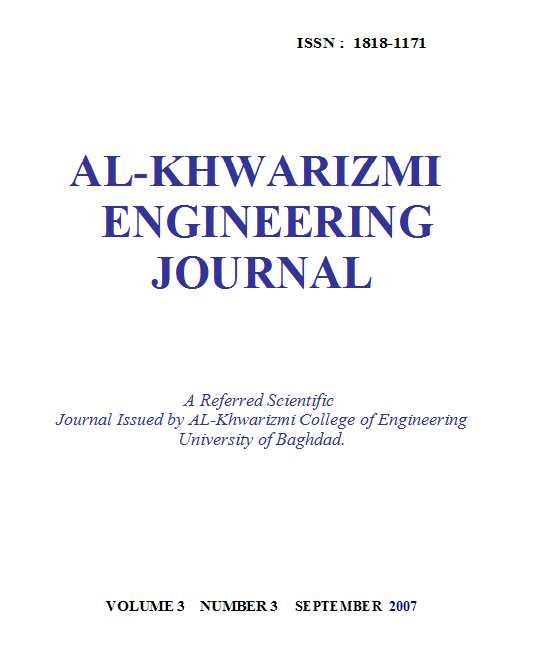Study of Mechanical Characteristics for Polymer Composite Reinforced by Particles of (Al2O3) or (Al)
Abstract
A particulate polymer composite material was prepared by reinforcing with the Aluminum Oxide (Al2O3) or Aluminum (Al) metallic particles with a particle size of (30) µm to an unsaturated Polyester Resin with a weight fraction of (5%, 10%, 15%, 20%).
Tensile test results showed the maximum value of elastic modulus reached (2400MPa.) in the case of reinforcing with (Al) particles with weight fraction (20%) and (1500 MPa.) in the case of reinforcing with (Al2O3) particles of the same weight fraction.
When the impact and the flexural strength tests were done, the results showed that flexural strength (F.S), maximum shear stress (τmax), impact strength (Gc) and fracture toughness (Kc) were increased with the increase of weight fraction, where the results of the samples of (Al) particles were higher than that of (Al2O3) particles reinforced at a weight fraction of (20%) at ratios of (45.43%, 45.45%, 25%, 41%) respectively. While the hardness of the samples reinforced with (Al2O3) particles was higher than that reinforced with (Al) particles with a ratio of (2.82%) at a weight fraction of (20%).
Downloads
References
2- J. W. Weeton, M. P. Dean, L.T. Karyn, '' Engineering's Guide to Composite Material'', Published by American Society for Metals,(1987).
3- N. L. Hancox, " Metals and Material "Vol.2 (1986).
4- W.D.Callister,Jr.,"Materials Science and Engineering An Introduction" 6th ed., John Wiely and Sons,Inc. 2003.
5- L. Nicolais, G. Guerra, C.Migliaresi, L. Niccdemo & A. Dibeenedetto, "Mechanical Properties of Glass – Bead Filled Polystyrene Composite", Journal of Composite, Vol.12 (1981).
6- M. Maik & A. Krysztafkiewicz,'' Effect of Fillers on the Properties of Urethane Polymers'', International Journal Polymer Science and Technology, Vol.8 (1981).
7- A. C. Moloney, H. H. Kuszh & H. R. Stieger, " The Fracture of Particulaate - Filled Epoxiede Resins ",Part1 Journal of Materials Science, Vol.18 (1983).
8- N. Amdouni , H. Sautereau , J. F. Gerard , F. Fernagut , G. Coulon & J. M. Lefebvre'' Coated Glass Beads Epoxy Composites: Influence of the Interlayer Thickness on Pre–Yielding & Fracture Properties'', Journal of Materials Science, Vol.25,(1990).
9- H. A. Kereem,'' Study the Influence of Adding Nickel Powder to a Thermosetting Epoxy Resin on the Mechanical Properties'',M. Sc. Thesis, University of Technology,(2002).
10- P. R. Marur , R. C. Batra, G. Garcia & A. C. Loos ,''Static & Dynamic Fracture Toughness of Epoxy /Alumina Composite with Submicron Inclusions '', Journal of Material Science, Vol.39, (2004).
11- R. J. Crawford," Plastic Engineering", 2nd ed., Pergamonl Press, U.K, (1987).
12- D. R. Askeland & P. P. Phule ," The Science & Engineering of Materials"4th ed., (2003).
13- B. R. Sanders & T. L. Weintraub, " Matel Hand Book Mechanical Testing " ,Vol.8 , 9th ed. ,USA, (1985).
14- N. G. Mccrum, C. P. Buckley & C. B. Bucknall "Principles of Polymer Engineering", 2nd ed., John Wiley & Sons, New York, (1997).
15- Annual Book of ASTM Standards, 1986, Vol. 08.01, D2240-86.
16- I. J. McColm " Ceramic Science for Materials Technologists ", Leonard Hill, New York, 1983.
17- A. C. Moloney, H. H. kausch & H. R. Beer, " Review Parameters Determining the Strength & Toughness of Particulate Filled Epoxide Resins", Journal of Materials Science, Vol.22, No. 2, 1987.
18- G. Piatti,"Advances in Composite Materials", Applied Science Publishers LTD, 1978.
19- J. Spnoudakis & R. J. Young, "Crack Propagation in a Glass Particle- Filled Epoxy Resin", Journal of Materials Science ,Vol.19, 1984.
Downloads
Published
Issue
Section
License
Copyright: Open Access authors retain the copyrights of their papers, and all open access articles are distributed under the terms of the Creative Commons Attribution License, which permits unrestricted use, distribution, and reproduction in any medium, provided that the original work is properly cited. The use of general descriptive names, trade names, trademarks, and so forth in this publication, even if not specifically identified, does not imply that these names are not protected by the relevant laws and regulations. While the advice and information in this journal are believed to be true and accurate on the date of its going to press, neither the authors, the editors, nor the publisher can accept any legal responsibility for any errors or omissions that may be made. The publisher makes no warranty, express or implied, with respect to the material contained herein.












